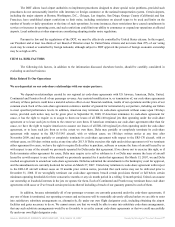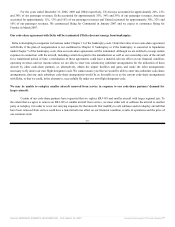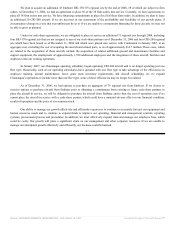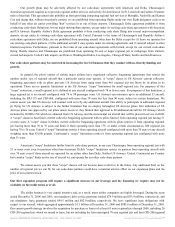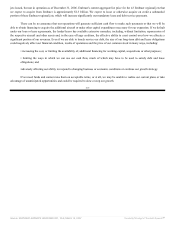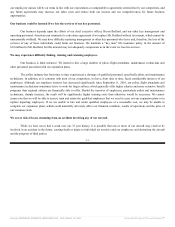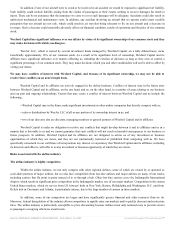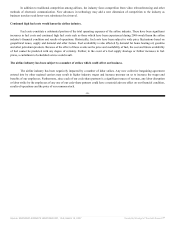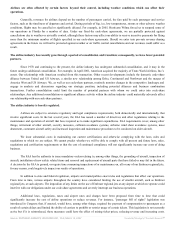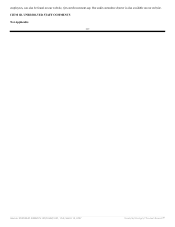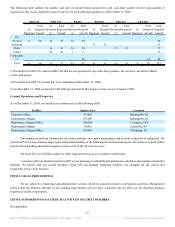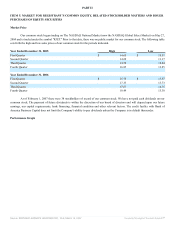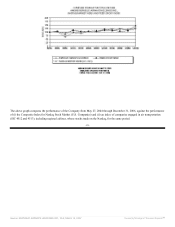Frontier Airlines 2006 Annual Report Download - page 39
Download and view the complete annual report
Please find page 39 of the 2006 Frontier Airlines annual report below. You can navigate through the pages in the report by either clicking on the pages listed below, or by using the keyword search tool below to find specific information within the annual report.
Airlines are often affected by certain factors beyond their control, including weather conditions which can affect their
operations.
Generally, revenues for airlines depend on the number of passengers carried, the fare paid by each passenger and service
factors, such as the timeliness of departure and arrival. During periods of fog, ice, low temperatures, storms or other adverse weather
conditions, flights may be cancelled or significantly delayed. For example, in 2005, Hurricane Wilma forced us to suspend some of
our operations in Florida for a number of days. Under our fixed-fee code-share agreements, we are partially protected against
cancellations due to weather or air traffic control, although these factors may affect our ability to receive incentive payments for flying
more than the minimum number of flights specified in our code-share agreements. Should we enter into pro-rate revenue sharing
agreements in the future we will not be protected against weather or air traffic control cancellations and our revenues could suffer as a
result.
The airline industry has recently gone through a period of consolidation and transition; consequently, we have fewer potential
partners.
Since 1978 and continuing to the present, the airline industry has undergone substantial consolidation, and it may in the
future undergo additional consolidation. For example, in April 2001, American acquired the majority of Trans World Airlines, Inc.'s
assets. Our relationship with American resulted from this transaction. Other recent developments include the domestic code-share
alliance between United and US Airways, a similar new relationship among Delta, Continental and Northwest and the merger of
America West and US Airways. We, as well as our code-share partners, routinely monitor changes in the competitive landscape and
engage in analysis and discussions regarding our strategic position, including potential alliances and business combination
transactions. Further consolidation could limit the number of potential partners with whom we could enter into code-share
relationships. Any additional consolidation or significant alliance activity within the airline industry could materially adversely affect
our relationship with our code-share partners.
The airline industry is heavily regulated.
Airlines are subject to extensive regulatory and legal compliance requirements, both domestically and internationally, that
involve significant costs. In the last several years, the FAA has issued a number of directives and other regulations relating to the
maintenance and operation of aircraft that have required us to make significant expenditures. FAA requirements cover, among other
things, retirement of older aircraft, security measures, collision avoidance systems, airborne wind shear avoidance systems, noise
abatement, commuter aircraft safety and increased inspection and maintenance procedures to be conducted on older aircraft.
We incur substantial costs in maintaining our current certifications and otherwise complying with the laws, rules and
regulations to which we are subject. We cannot predict whether we will be able to comply with all present and future laws, rules,
regulations and certification requirements or that the cost of continued compliance will not significantly increase our costs of doing
business.
The FAA has the authority to issue mandatory orders relating to, among other things, the grounding of aircraft, inspection of
aircraft, installation of new safety related items and removal and replacement of aircraft parts that have failed or may fail in the future.
A decision by the FAA to ground, or require time consuming inspections of or maintenance on, all or any of our Embraer regional jets,
for any reason, could negatively impact our results of operations.
In addition to state and federal regulation, airports and municipalities enact rules and regulations that affect our operations.
From time to time, various airports throughout the country have considered limiting the use of smaller aircraft, such as Embraer
regional jets, at such airports. The imposition of any limits on the use of Embraer regional jets at any airport at which we operate could
interfere with our obligations under our code-share agreements and severely interrupt our business operations.
Additional laws, regulations, taxes and airport rates and charges have been proposed from time to time that could
significantly increase the cost of airline operations or reduce revenues. For instance, "passenger bill of rights" legislation was
introduced in Congress that, if enacted, would have, among other things, required the payment of compensation to passengers as a
result of certain delays and limited the ability of carriers to prohibit or restrict usage of certain tickets. This legislation is not currently
active but if it is reintroduced, these measures could have the effect of raising ticket prices, reducing revenue and increasing costs.
Source: REPUBLIC AIRWAYS HOLDINGS INC, 10-K, March 15, 2007 Powered by Morningstar® Document Research℠


